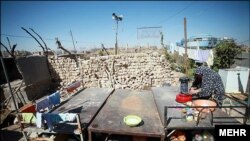A prominent Iranian economist says 33 percent of the country’s population live in absolute poverty, and six percent are starving.
A family of four living in an urban area with a monthly income below forty million rials (roughly $1000) is living in poverty, Hossein Raghfar told state-run Iranian Students News Agency (ISNA) April 7.
Families in rural parts of the country with an income of less than 20 million rials per month live in poverty, Raghfar added.
While Iran’s Ministry of Cooperatives, Labor, and Social Welfare sets the poverty level income bar much lower at seven million rials (roughly $160) per month for a family of five, Raghfar says this amount is not even enough to feed the family. His calculation takes into account the cost of all necessary commodities, not just food, when setting the poverty line.
These contradictory approaches to measuring the poverty line in Iran have made the task of setting official poverty level income figures elusive in the past.
“Absolute poverty measures poverty in relation to the amount of money necessary to meet basic needs such as food, clothing, and shelter. ---The concept, therefore, fails to recognize that individuals have important social and cultural needs,” wrote the Financial Tribune published in Iran, on January 21. “This, and similar criticisms, led to the development of the concept of “relative poverty,” which defines poverty in relation to the economic status of other members of the society. As per this concept, people are poor if they fall below prevailing standards of living in a given societal context.”
Two years ago, Hossein Raghfar estimated that 30 million Iranians were living in relative poverty and twelve million in absolute poverty. Now, based on current statistics presented by Raghfar, 33 percent of Iran’s population, i.e. nearly 26 million people, are suffering from absolute poverty, and six percent, or five million people, are not even able to buy enough food. These people, Raghfar pointed out, also have other expenses like housing, transportation, and clothing.
Parviz Fattah, the president of the Imam Khomeini Relief Committee (IKRC), said March 5 that the number of applicants seeking assistance from the charity has gone up nearly 50 percent Since when? Compared to when?. But he also insinuated that not all those seeking assistance were genuinely in need.
IKRC is a tax-exempt state institution launched by the order of the Islamic Republic’s founder, Ayatollah Rouhollah Khomeini, to assist people incapable of making ends meet.
Fattah, a former Islamic Revolutionary Guards Corps (IRGC) commander and energy minister under President Mahmud Ahmadinejad, also said, “The IKRC has nearly five million clients, of whom three million are directly covered and receive monthly allowances, while two million are receiving assistance according to their needs.”
According to an October 2017 report by the World Bank, “Iran is the second largest economy in the Middle East and North Africa (MENA) region after Saudi Arabia, with an estimated Gross Domestic Product (GDP) in 2016 of $412.2 billion---Iran ranks second in the world in natural gas reserves and fourth in proven crude oil reserves. Economic activity and government revenues still depend to a large extent on oil revenues and therefore remain volatile.”





